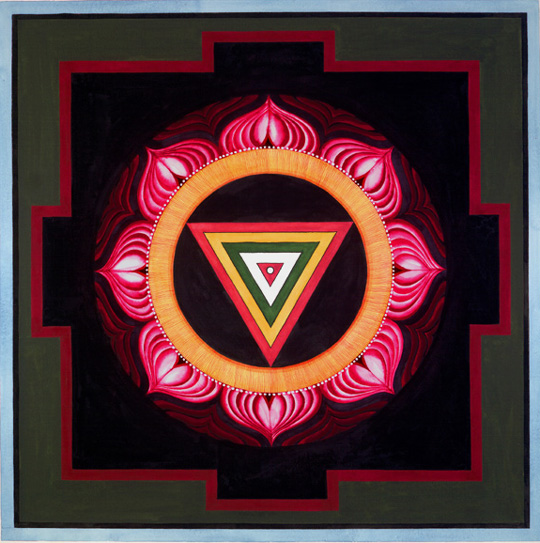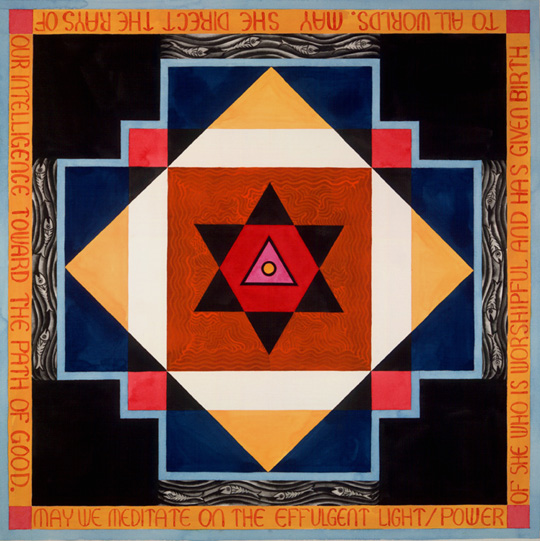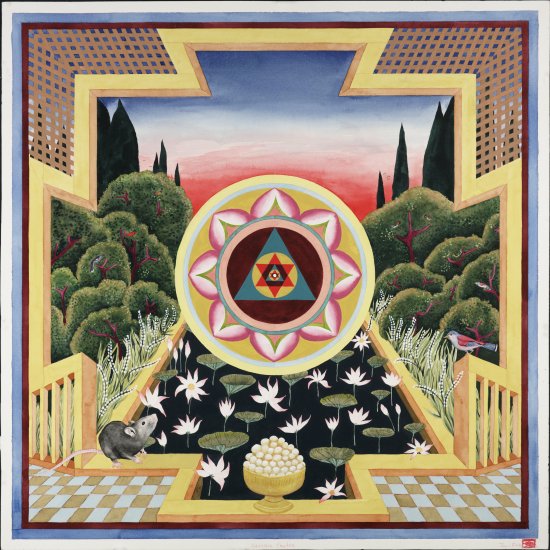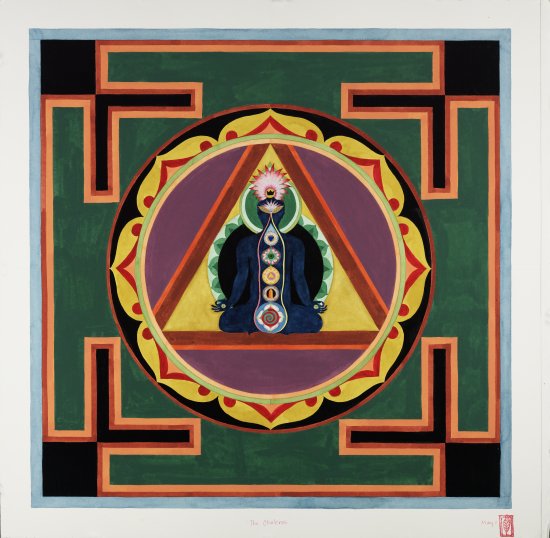Kali II
Sri-Laksmi
Sri-Laksmi’s birth is said to be the result of the austerities of Prajapati, the great progenitor. Sri is invoked to bring fame and prosperity. She is said to bountiful and to give abundance, and to bestow on her worshiper gold, cattle, horses, and food. She is asked to banish her sister, Alaksmi, “misfortune,” who appears in such inauspicious forms as need, poverty, hunger and thirst. She is delighted by the sounds of elephants. In outward appearance she is glorious and richly ornamented. She is radiant as gold, illustrious like the moon. She is often said to shine like the sun and to be lustrous like fire. She is associated with the lotus which is a symbol of fertility and life. This fertility is rooted in and takes its strength from the primordial waters. The lotus symbolizes vegetative growth that has distilled the life-giving power of the waters into embodied life. It is this lotus-power that is revealed in Sri-Laksmi.
Derived from the writings of David Kinsley, Hindu Goddesses
Gayatri Yantra
One of the most important longer mantras, commanding great respect since Vedic times, is the Gayatri Mantra. It can be translated as: May we meditate on the effulgent light (or power) of S/He who is worshipful and who has given birth to all worlds. May S/He direct the rays of our intelligence toward the path of good.
Each of the syllables of the expanded mantra is linked with a deity, a color, a bodily mechanism, and a cosmic principle. The mantra is inscribed in a circular fashion, symbolically integrating a whole mantra-picture of the universe with the yantra form. The colors used in this yantra were taken from those linked to the syllables of the mantra.
Om Yantra
Om Hrim. The sound of Om is the most ancient and potent Hindu mantra. It is the primordial vibration that lights the bindu or Center of existence. One source says that the word Hrim denotes the unity of the male and female principles or all opposition. Others suggest that the H stands for Siva, the R for Prakriti or nature, the I for Maya or creative play, the M for the dispeller of sorrow. Hrim is also the seed mantra of the goddesses Tripura-Sundari, and Tripura- Bhuvanesvari, two of the Mahavidyas presented elsewhere in these pages.
Nava Yoni Yantra
Nava Yoni Chakra, or Nine Cosmic Wombs, signifies the creation of the universe by the union of male and female principles represented by three interpenetrating upward and downward-pointing triangles. The resulting nine triangles create the nine Cosmic Wombs. The five triangles pointing downward are said to symbolize evolution, multiplication, and disintegration. The four upward symbolize awakened kundalini and movement toward primordial unity. The yantra may be read from the bindu in the center outward following the path of expanding creation or from the gates inward, the path home to the One. It brings forth the presence of the diety,Tripura-sundari (see the Mahavidyas).
Kali Yantra
This yantra brings forth the energy of Kali, one of the most awe-inspiring deities of the Hindu pantheon, and the only consort of Siva remaining autonomous and powerful unto herself. She is the energetic source of what we conceive of as our universe, and manifests the energetic original unity of the transcendental in her feminine form. Kali is also the annihilating and illuminating power of time. The energies of creation and dissolution are condensed in her yantra. Kali herself appears in the central drop or bindu as the conscious source or womb of the world. Kali is Supreme Mother. It is suggested that the symbols of the Kali yantra are to be drawn into the body of the viewer, for Kali is both a cosmic reality and psychic fact.
Ganesha Yantra
Born in the heat of a passionate dialectic and an ensuing intense struggle for dominance between his parents, the goddess Parvati and god Siva. Parvati demanded inviolate time to herself and Siva demanded access to her whenever he desired. In response to this conflict Parvati fashioned the boy Ganesha from unguents and dirt scraped from her body and breathed life into him to be her son and protector to guard her door. Subsequently, Siva decapitated Ganesha in a fight to gain entrance to Parvati. Parvati as the diva of worldly existence then moved to withdraw her phenomenal energy from the universe, threatening the collapse of all creation. Siva repented and vowed to send one of his retinue bring back the head of the first being he met in order to bring Ganesha back to life. The head was that of an elephant. Ganesha, connected to his new head, was revived and Siva claimed him has his son as well. Ganesha is envisioned as having a fat childish body on top of which is his large elephant’s head. He is said to embody an earth-bound awareness that protects the divine secret from unripe minds.
So, if we want to know the secrets of this world as a manifestation of the divine we must first receive the blessings of Ganesha. Ganesha’s mount is the rat. With his elephant-like nature he can boldly forge a new path through the world. And with the aid of his rat mount, he can travel deeply into a situation, getting beneath the foundation of things, and permeate the obscure. So as he obstructs, so he also offers insight and a way past obstructions and defeat. This is why Ganesha is invoked before the beginning of any enterprise among Hindus.
Risdra Siva Yantra
Creation Myth
Prajapati, the first god, from whom all gods and beings evolved, and some say, who, through austerities eventually became Brahma, brought forth many children one of whom was his daughter, Usas, the Dawn. Usas was a goddess of sublime beauty. Usas ushered in each day with her gentle glorious luminescence. Because of ushering in the mighty sun god, Surya, she was invoked as the Eye of the Gods. She was ever the young woman and the immortal divine one who bestowed material wealth upon her people.
Prajapati developed a mighty lust for his daughter. As the phenomenal lustful tension build in their household, Usas fled and frantically turned herself into a doe to escape. Prajapati then turned himself into a buck, caught up and mated with her. Some say that from this union came the four-legged beings.
Thereafter, every time Prajapati chased after her she took another form, and her father the same form as well, and from this countless mating came all animal life on Earth. But the gods were angry with Prajapati for his wonton behavior and wanted to punish him but could not do so by themselves. So they combined their most dread powers producing The Unnamed God (Rudra Siva) and asked him to punish Prajapati. And Siva agreed on condition that he become lord of cattle. He shot an arrow at the offending Prajapati and struck him. Prajapati instantly rose to the sky and became the constellation Mriga, occupying approximately the position of Orion.
The Chakras Yantra
The practice of meditation, realizing and using the energy centers of the body, has evolved from remotest antiquity. There are symbols in the vast natural caves of Paleolithic Europe (c. 20,000 BC) which can be accurately matched with symbols still used today by those involved with Tantric meditation and practice. This yantra was created after studying a number of paintings of the chakras from various centuries. They were made to aid the practitioner by expressly stimulating a special kind of mental activity, and to evoke psychosomatic energetic forces. To look at this image meditatively is to bring forth an esoteric sense of who one truly is, and what is possible. “Tantra has always believed that our failure to grasp time lies at the room of all other human failures. To see the nature of time is to understand the process of Genesis, that ladder of descending stages from the Origin through the evolution of the cosmos. Once we grasp that, we can, so to speak, reverse the machine for ourselves, and climb back up the ladder of Genesis. To reach that summit of intuition Tantra holds to be the worthwhile goal.”
Tantra: The Indian Cult of Ecstasy, Philip Rawson









